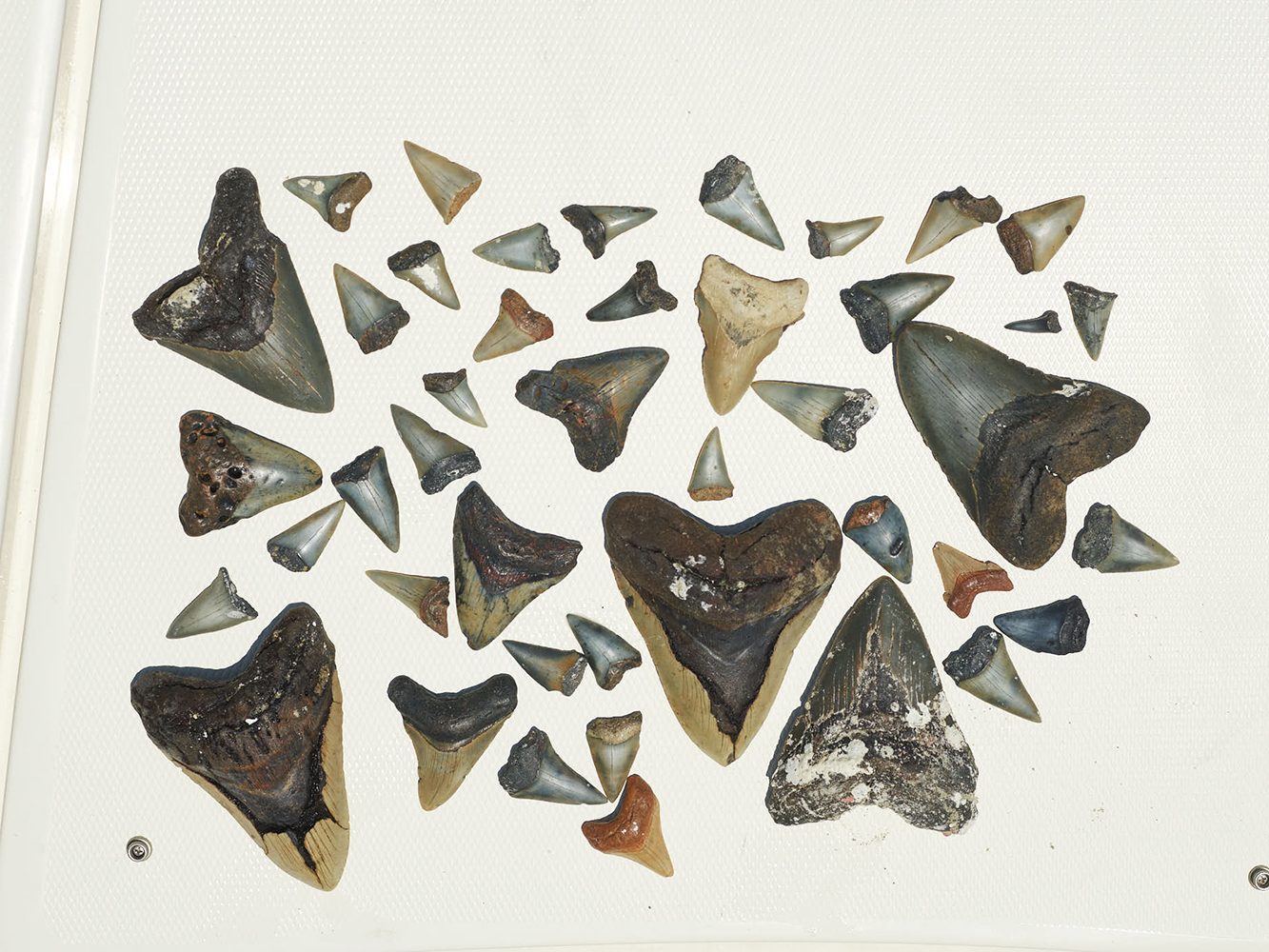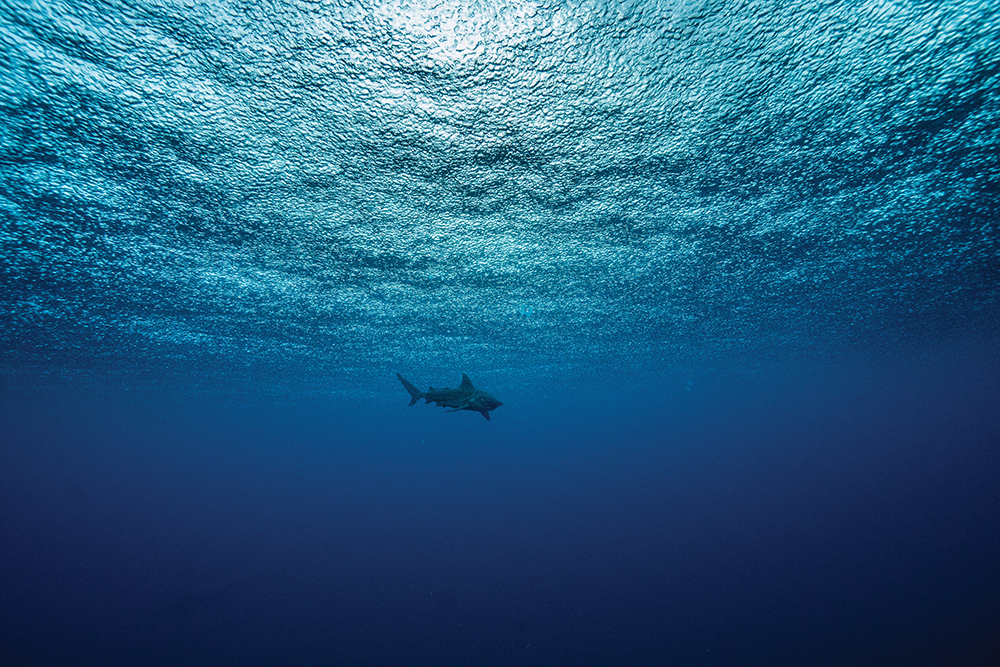Our state is a hotspot for discovering fossilized shark teeth. We talked to an expert to learn why — and get some tips on how to find them.
by Emma Deal, Nelie Tahssili & Eliza Martin | photography by Joshua Steadman
Among our bragging rights here in Raleigh, we like to remind folks that when the going gets hot, it’s a quick trip out to the beach for some relief. And if you’ve taken a stroll along a North Carolina shore, you may have uncovered another one of our treasures among the shells: shark teeth. From itty-bitty serrated triangles to ancient megalodon chompers as big as your head, it’s not uncommon to find fossilized shark teeth tucked among the sand and shells.
“Fossil shark teeth can be found on many beaches around the world, but our state is a particular hotspot,” says Dr. Christian Kammerer, research curator of paleontology at the North Carolina Museum of Natural Sciences. We talked to him to find out why — and how to find them.
Why do North Carolina shores have more shark teeth than others?
This is because of a mix of geography and geology — basically, rocks of the right age are exposed coastally below the waterline. Erosion, for example by wave action, pulls fossils out of these rocks and then they are redeposited on the shore. There are particularly extensive sub-aqueous outcrops of fossil-bearing sediment containing marine fossils from the Cenozoic Era, the age of mammals, off portions of the Carolina coast, so we get lots of shark teeth on the beaches.
Is that because there were lots of sharks in the past?
Sharks were not themselves more abundant in the deep past than they are in more recent ecosystems, but there are far more of their fossils in the record than many other groups of animals. This is because of their high preservation potential, which just means how likely it is for an organism to be fossilized. Shark teeth have two major advantages over other fossils: they are very hard and very numerous. Sharks are constantly replacing their teeth in a “conveyor belt”-like manner. When a shark loses its tooth, a new one pops out to replace it, and they are always growing new teeth lower in the jaw to ready these replacements. In fact, some sharks can grow up to 50,000 teeth in their lifetimes! And sharks lose teeth all the time — for many species, they lose teeth nearly every time they bite down, so an individual shark will lose thousands of teeth in its lifespan. Because of this, each individual shark has a far greater chance of contributing to the fossil record than most other animals, which is reflected in the abundance of their teeth at fossil sites.

So are all the teeth we find considered fossils?
Modern sharks also are constantly losing teeth, and because of this you can also find non-fossil shark teeth at the beach with some frequency. It can be difficult to tell modern and fossil teeth apart. If you find a shiny white tooth it’s probably modern, if you find a darker-colored tooth — especially jet black ones — it’s probably a fossil, but there are exceptions to both. I’ve seen pure white fossils millions of years old, and recent teeth that have turned brown or gray because they have been in organic-rich waters for only a few hundred years.
We’ve heard you can also find megalodon teeth — how would you know the difference between a regular shark tooth and a megalodon tooth?
The teeth of Carcharocles megalodon, the mega-toothed shark, are our state fossil and certainly one of the most sought-after specimens by collectors. This is a completely extinct species, so all of its teeth are fossils. General pointers on identifying a megalodon tooth are size: they can get substantially larger than any other shark’s teeth, up to 7 inches long. They are also very thick compared to most other shark teeth, with well-developed serrations on the edges. Of course, most megalodon teeth that are found are much smaller than the maximum size, but can be identified by the presence of a characteristic V-shaped dental band exposed on the inner face of the tooth, above the root.
Where do people find the most shark teeth?
Going directly to the source can be a good idea. I know there are folks who run charters over the underwater outcrops, particularly where megalodon teeth are abundant, and dive down to collect them. You do have a very good chance to find teeth at those sites, but I would stress that it is by no means necessary to dive to make great discoveries — you can find specimens that are just as good on land with a bit of patience and an eye for detail.
What’s the best shark tooth you’ve ever found?
Any tooth? Probably the “tooth whorl,” a spiral pavement of teeth that covered the entire jaw of an extremely ancient species of shark-like fish, which I collected on an expedition to northern Brazil. Individual fragments of the whorl are common, but an associated set of the teeth is very rare indeed. Here in North Carolina, my favorite sharks’ teeth that I have found are actually all much older than megalodon — they’re teeth from the age of dinosaurs that come out of Cretaceous rocks out east. Lots of these animals, like Squalicorax, Scapanorhynchus and Cretalamna, have not survived to the present day and represent either entirely extinct lineages or, in the case of Scapanorhynchus groups of sharks that exist today, only at low diversity in the deep sea.
This article originally appeared in the July 2023 issue of WALTER magazine.







Pingback: The Best North Carolina Beaches to Find Shark Teeth - WALTER Magazine